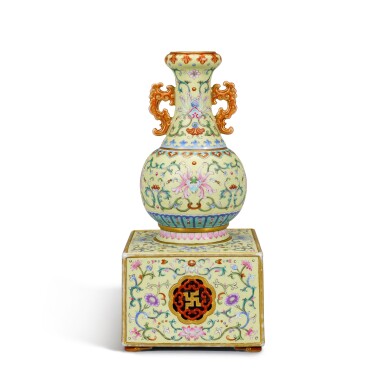Important Chinese Art
Important Chinese Art

An extremely rare and possibly unique yellow-ground yangcai reticulated vase, Seal mark and period of Qianlong | 清乾隆 米黃地洋彩錦上添花纏枝花卉紋方座瓶 《大清乾隆年製》款
拍卖已结束
April 8, 02:15 PM GMT
估价
3,000,000 - 4,000,000 HKD
拍品信息
描述
An extremely rare and possibly unique yellow-ground yangcai reticulated vase,
Seal mark and period of Qianlong
清乾隆 米黃地洋彩錦上添花纏枝花卉紋方座瓶 《大清乾隆年製》款
h. 26.1 cm
Collection of an English gentleman, acquired in the early 20th century, and thence by descent.
英國私人收藏,購藏於二十世紀初,此後家族傳承
This exquisite piece, modelled as a charming garlic-mouth vase raised on a reticulated pedestal, painted in yangcai enamels with an ornate composition of floral blooms, belongs to a select group of porcelain produced for the Qianlong Emperor in the early years of his reign. Under the creative genius of Tang Ying (1682-1756), superintendent of the imperial kilns in Jingdezhen, individually conceived pieces were composed according to the aesthetic direction of the Emperor. New forms, colours and techniques were continuously explored while drawing inspiration from various mediums, as evident in this possibly unique vase.
As the term yangcai (‘Western colours’) suggests, the palette is inspired by European paintings, which relied heavily on the use of white pigment. The craftsman of the present piece has employed predominantly foreign pastel hues and placed them against a soft, pale yellow ground. Yangcai ware was greatly appreciated by the Qianlong Emperor, and it was housed primarily in his largest private quarters, the Qianqinggong (Palace of Heavenly Purity), located in the Inner Court of the Forbidden City, and in the European-style palaces of the Yuanmingyuan. Liao Pao Show, in ‘On Yang-ts’ai Porcelains of the Ch’ien-lung Reign’, Stunning Decorative Porcelains from the Ch’ien-lung Reign, Palace Museum, Taipei, 2008, p. 36, notes that the production of yangcai porcelain was perfected under Tang after the sixth year of Qianlong, following the Emperor’s complaint that the porcelains made in the first six years of his reign were of significantly lower quality than those from the previous Yongzheng period. As a result, sixty-nine pieces of yangcai porcelain are recorded as having been presented to the Qianlong Emperor in the eighth month of the seventh year of his reign (corresponding to 1741).
The Qianlong Emperor enjoyed objects that were technically pioneering and unconventional in their aesthetics. The current piece, incorporated with a reticulated square pedestal with lattice cartouches providing glimpses into the inner blue-and-white core, epitomises the artistic advancements of this period. No other examples with such a design appear to be recorded. However, a reticulated yangcai yellow vase of a square section from the Qing court collection, but without a blue-and-white inner layer and raised on a galleried stand, is preserved in the Palace Museum, Beijing, and illustrated in The Complete Collection of Treasures of the Palace Museum. Porcelains with Cloisonné Enamel Decoration and Famille Rose Decoration, Hong Kong, 1999, pl. 146 and cover.
This vase is further embellished with incised curling fronds in the sgraffiato technique. Commonly known as jinshangtianhua (‘adding decorative pattern onto brocades’), the development of this laborious needle-point etching technique is also attributed to Tang Ying. Such rich decoration, coupled with the harmonious spacing of the floral scroll, is reminiscent of French rococo textiles, specimens of which would have entered the court through Jesuit missionaries and merchants in Guangdong and catered perfectly to the Qianlong Emperor’s predilection for the opulent.
A range of yellow tones was used as colour grounds on Qianlong yangcai porcelain, but this pastel yellow is remarkable for its softness and rarity. Compare a pale-yellow ground double-gourd vase, intricately decorated with intricate floral scrolls intertwined with wan lattice, formerly in the collection of J.T. Tai, sold in these rooms, 7th October 2010, lot 2126.
Notably, the use of two distinct geometric shapes in this piece, with the circle represented by the vase and the square in the form of a cubic pedestal, symbolises the pairing of Heaven and Earth. Since ancient times, the Chinese considered Heaven to be round and Earth to be square, and the two together were compared to the round canopy and square body of the chariot. Heaven thus became the dome that covered the flat Earth.
本品精緻典雅,鏤雕方形底座盛雙耳尊,洋彩繪纏枝花卉紋,運用方圓造形,象徵天地,天圓地方,屬乾隆朝早期之作。是時,唐英(1682-1756年)任景德鎮御窰廠督陶官,致力創燒各式新穎瓷器,以適皇帝審美喜好,廣探各式器形、釉彩、裝飾技術,甚至取材各種媒材等,一如本品,獨特不見類例,或為孤品。
洋彩源自西洋,色調取材歐洲繪畫,需使用大量白彩調製,本品淡黃彩地,紋飾色彩宛似西洋粉彩畫,柔美可人。乾隆皇帝喜愛洋彩瓷,多陳設於乾清宮,位於紫禁城內廷,屬規模最大之內宮,以及圓明園。廖寶秀,《華麗彩瓷:乾隆洋彩》,故宮博物院,台北,2008年,頁36,提及乾隆六年之後,洋彩瓷燒造達到巔峰,或因皇帝曾責問為何此前官瓷品質遜於雍正窰,檔案記載乾隆七年八月,上呈六十九件洋彩瓷。
乾隆皇帝喜見技術創新及新穎設計,本品鏤雕方座與青花內膽相互輝映,展現當朝造瓷技術之成就,著錄無見相類品,清宮舊藏見一例黃地鏤雕方座者,無青花內膽,現藏北京故宮博物院,刊於《故宮博物院藏文物珍品全集:琺瑯彩.粉彩》,香港,1999年,圖版146及封面。
淡黃地上以細針錐剔錦地,稱之錦上添花,乃唐英所創,托襯疏朗花卉紋,宛似西洋進貢之洛可可風格織錦,經由廣東上進至朝廷。
乾隆洋彩瓷可見深淺不同之黃地,如本品之輕柔淡黃彩則甚罕見,比較戴潤齋舊藏清乾隆淺黃地洋彩錦上添花「萬壽連延」圖大吉葫蘆瓶,2010年10月7日售於香港蘇富比,編號2126。
